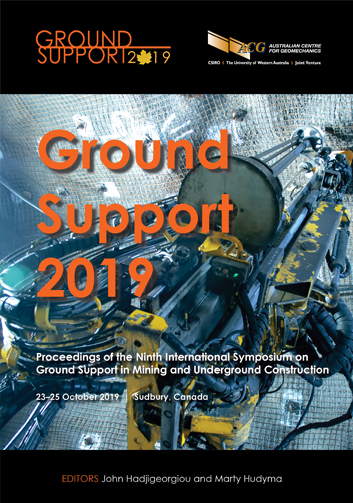Assessing the contribution of seismicity to the demand on ground support elements at LaRonde mine

|
Authors: Sasseville, G; Grenon, M; Morissette, P |
DOI https://doi.org/10.36487/ACG_rep/1925_09_Grenon
Cite As:
Sasseville, G, Grenon, M & Morissette, P 2019, 'Assessing the contribution of seismicity to the demand on ground support elements at LaRonde mine', in J Hadjigeorgiou & M Hudyma (eds), Ground Support 2019: Proceedings of the Ninth International Symposium on Ground Support in Mining and Underground Construction, Australian Centre for Geomechanics, Perth, pp. 155-168, https://doi.org/10.36487/ACG_rep/1925_09_Grenon
Abstract:
Seismic activity is known to affect the short- and long-term behaviour of mining ground support, yet the influence of seismicity on ground support demand is not fully understood. This paper quantitatively assesses the influence of various seismic parameters on the performance and degradation of ground support elements. A large database was created using the LaRonde mine (Quebec, Canada) as a case study, which consolidates information on the history of the rock support of an entire mine sector comprising 18.5 km of drifts: type, installation date, and behaviour over time. This database was linked with the seismic event database available at the mine. Analyses identified various seismic parameters (i.e. large seismic events, number of seismic events, increase in apparent stress, b-value from the Gutenberg–Richter frequency–magnitude relationship, peak particle velocity, and energy radiated from the event) as precursory trends that may influence the performance and degradation of ground support elements. A key finding is that the number of seismic events and their magnitude are contributing factors in controlling the demand on ground support. A high number of seismic events and high local magnitude event have frequently been recorded before observing degradation on ground support elements. Another important finding is that the demand on ground support cannot be explained entirely by seismicity; it is also controlled by other site factors.
Keywords: ground support, seismicity, database, degradation, demand
References:
Brown, L & Hudyma, M 2017, ‘Identification of stress change within a rock mass through apparent stress of local seismic events’, Rock Mechanics and Rock Engineering, vol. 50, no. 1, pp. 81–88.
CANMET 2000, unpublished notes, LaRonde mine.
Durrheim, J, Roberts, MKC, Haile, AT, Hagan, TO, Jager, AJ, Handley, MF, Spottiswoode, SM & Ortlepp, WD 1998, ‘Factors influencing the severity of rockburst damage in South African gold mines’, Journal of the South African Institute of Mining and Metallurgy, vol. 98, no 2, pp. 53–57.
Gutenberg, B & Richter, CF 1944, ‘Frequency of earthquakes in California’, Bulletin of the Seismological Society of America, vol. 34, no. 4, pp. 185–188.
Hadjigeorgiou, J 2016, ‘Rock support: degradation and failure’, in E Nordlund, T Jones & A Eitzenberger (eds), Proceedings of the Eighth International Symposium on Ground Support in Mining and Underground Construction, Luleå University of Technology, Luleå.
Hadjigeorgiou, J & Potvin, Y 2011, ‘A critical assessment of dynamic rock reinforcement and support testing facilities’, Rock Mechanics and Rock Engineering, vol. 44, no. 5, pp. 565–578,
Heal, D, Potvin, Y & Hudyma, M 2006, ‘Evaluating rockburst damage potential in underground mining’, Proceedings of the 41st US Symposium on Rock Mechanics, American Rock Mechanics Association, Alexandria.
Hedley, DGF 1992, Rockburst Handbook for Ontario Hardrock Mines, CANMET special report SP92-1E.
Hudyma, M & Potvin, Y 2010, ‘An engineering approach to seismic risk management in hardrock mines’, Rock Mechanics and Rock Engineering, vol. 43, no. 6, pp. 891–906.
Kaiser, PK, & Cai, M 2012, ‘Design of rock support system under rockburst condition’, Journal of Rock Mechanics and Geotechnical Engineering, vol. 4, no. 3, pp. 215–227.
Kaiser, PK & Maloney, S 1997, ‘Scaling laws for the design of rock support’, Pure and Applied Geophysics, vol. 150, no. 3–4,
pp. 415–434.
Kaiser, PK, Tannant, DD & McCreath, DR 1996, Canadian Rock Burst Support Handbook, Geomechanics Research Centre, Sudbury.
Karampinos, E 2016, Management of Squeezing Ground Conditions in Hard Rock Mines, doctoral dissertation, University of Toronto, Toronto.
Morissette, PNR 2015, A Ground Support Design Strategy for Deep Underground Mines Subjected to Dynamic-Loading Conditions, doctoral dissertation, University of Toronto, Toronto.
Morissette, P 2017, ‘Pro-active strategies for mitigating the consequences of strainbursts at LaRonde mine’, paper presented at the ACG Strainburst in Mining Seminar—How to Mitigate the Consequences, 10 October 2017, Sudbury.
Potvin, Y 2009, ‘Strategies and tactics to control seismic risks in mines’, Journal of the Southern African Institute of Mining and Metallurgy, vol. 109, no. 3, pp. 177–186.
Sasseville, G, Grenon, M & Morissette, P 2019, ‘Identification of critical factors contributing to increased demand on ground support elements at LaRonde mine’, Proceedings of the 53rd US Rock Mechanics/Geomechanics Symposium, American Rock Mechanics Association, Alexandria.
Simser, BP 2007, ‘The weakest link—ground support observations at some Canadian Shield hard rock mines’, in Y Potvin (ed.), Proceedings of the 4th International Seminar on Deep and High Stress Mining, Australian Centre for Geomechanics, Perth, pp. 335–348.
Vallejos, JA & McKinnon, SD 2011, ‘Correlations between mining and seismicity for re-entry protocol development’, International Journal of Rock Mechanics and Mining Sciences, vol. 48, no. 4, pp. 616–625.
Wesseloo, J (nd), Unpublished notes, Australian Centre for Geomechanics, Perth.
© Copyright 2025, Australian Centre for Geomechanics (ACG), The University of Western Australia. All rights reserved.
View copyright/legal information
Please direct any queries or error reports to repository-acg@uwa.edu.au
View copyright/legal information
Please direct any queries or error reports to repository-acg@uwa.edu.au